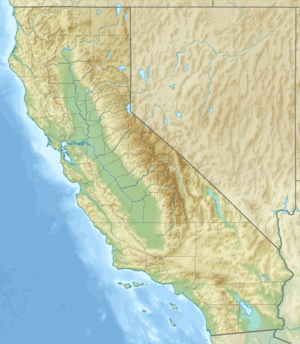McWay Creek facts for kids
Quick facts for kids McWay Creek |
|
|---|---|
|
Location of the mouth of McWay Creek in California
|
|
| Other name(s) | McWay Canyon |
| Country | United States |
| State | California |
| Region | Julia Pfeiffer Burns State Park |
| Physical characteristics | |
| Main source | Coast Range, Partington Ridge, California 3,000 ft (910 m) 36°11′13″N 121°39′15″W / 36.18694°N 121.65417°W |
| River mouth | Pacific Ocean Waterfall Cove, California 100 ft (30 m) 36°09′30″N 121°40′19″W / 36.15833°N 121.67194°W |
| Basin features | |
| Tributaries |
|
McWay Creek is a short, beautiful stream in Monterey County, California. It is about 2.5-mile-long (4.0 km). The creek flows down from McWay Canyon, which is high in California's Central Coast Range. It then empties into the Pacific Ocean at a place called Waterfall Cove. This is where you can see the amazing McWay Falls.
Most of McWay Creek and the land around it are inside Julia Pfeiffer Burns State Park. This park is about 12 miles (19 km) south of Pfeiffer Big Sur State Park. The creek got its name from Christopher McWay, a pioneer from New York. He was one of the first people to settle on the land here.
Years ago, a special machine called a Pelton wheel was put in McWay Creek. This machine used the water's power to make electricity for the Saddle Rock Ranch. It was the only electricity in the area for a long time! The creek and its canyon have many different types of plants. This is because the coast here is often foggy and gets a lot of rain.
Contents
Where is McWay Creek?
McWay Creek starts when two smaller streams, the North Fork and Middle Fork, join together. This happens at a height of about 1,270 feet (390 m). The North Fork is the longer stream. It begins very high up, at about 3,450 feet (1,050 m). It flows straight south until it meets the Middle Fork.
The Middle Fork is smaller and starts at about 3,182 feet (970 m). It flows southwest to join the North Fork. Once these two streams meet, they form the main part of McWay Creek. The creek then twists and turns through a narrow canyon. It meets another stream, the South Fork, at about 400 feet (120 m).
The South Fork is the biggest part of the McWay Creek area. It starts at about 2,559 feet (780 m) on one side of a ridge. After flowing south, it joins McWay Creek. The creek then goes southwest, past a parking area for Julia Pfeiffer Burns State Park. It flows under Highway 1 through a concrete tunnel. Finally, it spills into the Pacific Ocean at Waterfall Cove.
Amazing Waterfalls of McWay Creek
There are several beautiful waterfalls in the McWay Creek area. The most famous one is McWay Falls. This waterfall drops 80 feet (24 m) right onto a sandy beach at Waterfall Cove. It's a truly unique sight!
Upstream from Highway 1, there's a smaller waterfall called McWay Creek Falls. It has two levels and is about 30-foot (9.1 m) tall. Another small waterfall, Canyon Trail Falls, is about 30-foot (9.1 m) tall. It is fed by the South Fork just before it joins McWay Creek.
Because the creek flows through a steep and rocky area, there are many other unnamed waterfalls too. McWay Creek gets its water from several natural springs in McWay Canyon. This means the creek flows all year round, never drying up!
A Look Back: History of McWay Canyon
The canyon is named after Christopher McWay, who settled there in the late 1870s. Later, in 1924, a couple named Lathrop and Hélène Hooper Brown bought a large property called Saddle Rock Ranch from McWay. It was about 1,600 acres.
Another pioneer from the Big Sur area, Julia Pfeiffer Burns, rented land from the Browns to raise cattle. Hélène Brown and Julia became good friends. Sadly, Julia passed away in 1928. The Browns were the ones who installed the Pelton wheel in McWay Creek. This machine helped them create electricity for their ranch, which was a big deal back then!
Plants and Trees of McWay Canyon
The weather in Big Sur and McWay Canyon is often humid, with lots of fog and rain. This helps many different kinds of plants grow here. Near the coast, you'll find plants like willows, alders, western coltsfoot, and elk clover.
There are also redwood trees in McWay Canyon. However, the salty ocean air can make it hard for the redwoods closest to the shore to grow well. The ground is mostly covered by Coastal sage scrub. Among this scrub, you can see colorful flowers like monkey flowers, Indian paintbrush, common yarrow, blue blossom, and coast morning glory.
As you go further upstream, away from the coast, you'll start to see more oak trees and bay trees. The ground plants here include sword ferns, gooseberry, western wake robin, and redwood sorrel. In open areas of the forest, especially at higher elevations, you might find hedge nettle, bracken fern, and wild iris.
Redwoods are still common in the upstream parts of the watershed. Some people even say there's one of the biggest redwoods in the entire Big Sur area here! As you climb even higher, you'll see trees like live oak, chamise, and Coulter pine.


